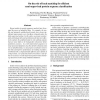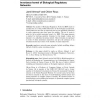104
Voted
BIBM
2008
IEEE
15 years 26 days ago
2008
IEEE
125
Voted
BIBM
2008
IEEE
15 years 26 days ago
2008
IEEE
This paper addresses the protein classification problem, and explores how its accuracy can be improved by using information from time-course gene expression data. The methods are ...
BIBM
2008
IEEE
15 years 2 months ago
2008
IEEE
Recent studies in protein sequence analysis have leveraged the power of unlabeled data. For example, the profile and mismatch neighborhood kernels have shown significant improveme...
BIBM
2008
IEEE
15 years 2 months ago
2008
IEEE
: The analysis of Biological Regulatory Network (BRN) leads to compute the set of the possible behaviours of the biological components. These behaviours are seen as trajectories an...
133
Voted
BIBM
2008
IEEE
15 years 2 months ago
2008
IEEE
The evolutionary histories of viral genomes have received significant recent attention due to their importance in understanding virulence and the corresponding ramifications to pu...
98
Voted
BIBM
2008
IEEE
15 years 7 months ago
2008
IEEE
We develop a parallel algorithm for a widely used whole genome alignment method called LAGAN. We use the MPI-based protocol to develop parallel solutions for two phases of the alg...
106
click to vote
BIBM
2008
IEEE
15 years 7 months ago
2008
IEEE
We present an EM-based clustering method that can be used for constructing or augmenting ontologies such as MeSH. Our algorithm simultaneously clusters verbs and nouns using both ...
115
Voted
BIBM
2008
IEEE
15 years 7 months ago
2008
IEEE
Abstract—The exact relationship between protein active centers and protein functions is unclear even after decades of intensive study. To improve the functional prediction abilit...
120
click to vote
BIBM
2008
IEEE
15 years 7 months ago
2008
IEEE
Protein fold recognition is the prediction of protein’s tertiary structure (Fold) given the protein’s sequence without relying on sequence similarity. Using machine learning t...
106
click to vote
BIBM
2008
IEEE
15 years 7 months ago
2008
IEEE
We adapt a network simulation algorithm called quantitative simulation (QSim) for use in the alignment of biological networks. Unlike most network alignment methods, QSim finds l...


